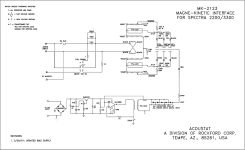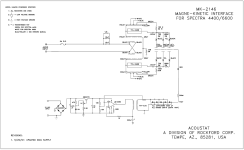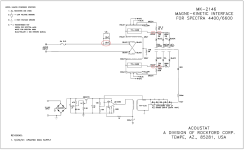Simple answer is no, as the eq is not the same.If I stacked a pair of Spectra 22's, and powered each interface (2 per side), would I have essentially a Spectra 44?
You could just try it though, you might like it, or be able to eq an acceptable performance to you.
But it is not essentially a Spectra 44.
Cheers
Gn
Thanks for your reply. How would it be different?
Here's the diagram for the Spectra series. As I understand it, it shows how the panels are wired if 1, 2, 3, or 4 or more panels. With 4 panels, it would seem to be a set of two panels on top of two panels, with the top two panels wired the same as the lower two panels. Please explain how it differs...Thanks.

Here's the diagram for the Spectra series. As I understand it, it shows how the panels are wired if 1, 2, 3, or 4 or more panels. With 4 panels, it would seem to be a set of two panels on top of two panels, with the top two panels wired the same as the lower two panels. Please explain how it differs...Thanks.
Last edited:
That is just the panel wiring diagram.
The pre-spectra models had 3 different bass transformer taps, to reduce the amount of bass, as number of panels increased from 2, to 3, to 4 panels. (whether 4 panels were all side by side, or stacked 2+2)
The Spectra interfaces do the same by having 2 different transformer taps for 2/3 panel systems, and different transformers with 2 different taps for the 4/6 panel systems.
So, panel wiring is the same, but the gubbins that feed the panels are different, as the number of panels increases.
Cheers
Gn
The pre-spectra models had 3 different bass transformer taps, to reduce the amount of bass, as number of panels increased from 2, to 3, to 4 panels. (whether 4 panels were all side by side, or stacked 2+2)
The Spectra interfaces do the same by having 2 different transformer taps for 2/3 panel systems, and different transformers with 2 different taps for the 4/6 panel systems.
So, panel wiring is the same, but the gubbins that feed the panels are different, as the number of panels increases.
Cheers
Gn
Bugger me you must be right.
Identical then. Get some Spectra 44 badges and you are done, just like a factory pair then.
Gubbins is the stuff inside the boxes, resistors, transformers etc. They are different values and turn ratios respectively, but you must be right because how can that be making any difference when the diagram above of the "panel wiring" is the same.
Best of luck.
Cheers
Gn
Identical then. Get some Spectra 44 badges and you are done, just like a factory pair then.
Gubbins is the stuff inside the boxes, resistors, transformers etc. They are different values and turn ratios respectively, but you must be right because how can that be making any difference when the diagram above of the "panel wiring" is the same.
Best of luck.
Cheers
Gn
There are some differences between the internal components(resistors capacitors) used in the Spectra22 and Spectra44 interfaces.
They are different to provide the appropriate EQ for the acoustic response of a shorter(22) or taller(44) line source.
But, as gnnett already mentioned, you could leave the Spectra22 interfaces as is and just use upstream EQ to tailor the response to your liking.
The most appropriate bass tap to use when stacking a pair of Spectra22s to emulate a Spectra44 would be the orange wire.
* NOTE *
Many of the previously posted Spectra22 Schematics have orange/red color labels for the bass taps incorrectly swapped.
More details here:
https://www.diyaudio.com/community/...tat-2123-interface-have-s.260684/post-4032543
https://www.diyaudio.com/community/...ify-these-acoustat-panels.269828/post-4229071
They are different to provide the appropriate EQ for the acoustic response of a shorter(22) or taller(44) line source.
But, as gnnett already mentioned, you could leave the Spectra22 interfaces as is and just use upstream EQ to tailor the response to your liking.
The most appropriate bass tap to use when stacking a pair of Spectra22s to emulate a Spectra44 would be the orange wire.
* NOTE *
Many of the previously posted Spectra22 Schematics have orange/red color labels for the bass taps incorrectly swapped.
More details here:
https://www.diyaudio.com/community/...tat-2123-interface-have-s.260684/post-4032543
https://www.diyaudio.com/community/...ify-these-acoustat-panels.269828/post-4229071
Attachments
Last edited:
That makes sense, thank you!
So, is the schematic for the 2136 interface which you have posted above correct with respect to the orange and red wiring indications, or does this schematic have the red and orange labels incorrectly identified as well?
Is it possible to swap components in the 2136 to make it compatible with the 2146 for use with 2 sets of stacked Spectra panels?
Thanks again.
So, is the schematic for the 2136 interface which you have posted above correct with respect to the orange and red wiring indications, or does this schematic have the red and orange labels incorrectly identified as well?
Is it possible to swap components in the 2136 to make it compatible with the 2146 for use with 2 sets of stacked Spectra panels?
Thanks again.
There are some differences between the internal components(resistors capacitors) used in the Spectra22 and Spectra44 interfaces.
They are different to provide the appropriate EQ for the acoustic response of a shorter(22) or taller(44) line source.
But, as gnnett already mentioned, you could leave the Spectra22 interfaces as is and just use upstream EQ to tailor the response to your liking.
The most appropriate bass tap to use when stacking a pair of Spectra22s to emulate a Spectra44 would be the orange wire.
* NOTE *
Many of the previously posted Spectra22 Schematics have orange/red color labels for the bass taps incorrectly swapped.
More details here:
https://www.diyaudio.com/community/...tat-2123-interface-have-s.260684/post-4032543
https://www.diyaudio.com/community/...ify-these-acoustat-panels.269828/post-4229071
As I said above, your explanation makes sense, but after considering this a bit more, I should think that if there was a different eq being applied by the interface in the MK-2146 for upper and lower panels, the wiring diagram I attached above would not only differentiate between panels side to side, but also top and bottom, yet it makes no mention of the latter. How indeed would the two upper and two lower panels be wired in the Spectra 44? Any ideas @AcoustatAnswerMan ?
No it is not eq'ed differently vertically.but also top and bottom, yet it makes no mention of the latter.
Please re-read what I said there about the original MK121 series.
In the original dual transformer series (MK121) the driven panel area dictated bass eq. The original 4 panel wide version has the same bass eq as the stacked 4 panel 2+2. The 2 panel (single height) model 2, uses the same bass eq as the stacked 2 panel 1+1.
The same applies to the bass eq of the Spectra series, with less bass for each increase in number of panels.
Interestingly, because this can vary with room size etc, the Spectra 44/66 (refer schematic above) provide 4 taps, two additional to allow modification of bass output, to suit room and taste.
To duplicate the 44/66 you would need to modify the resistors, capacitors AND swap out the transformers.
You could try it and you may have a large room that soaks up the extra bass energy, or it might suit your personal taste. Alternatively you could use DSP, or other eq methods, to achieve an even better outcome than factory. YMMV.
Best of luck
Gn
Hello. I am new to DIY, but I am a 30+ year owner of a pair of Acoustat 1+1 speakers. I purchased them used from a friend who was frustrated with the lack of bass. I took them off his hands, added a Vandersteen 2W subwoofer and have not looked back. Last year I replaced the Vandy with a pair of Rythmic F12SE subwoofers and put a SPL Crossover (SPL is out of Germany and the unit is similar to the JL Audio CR-1 here in the states). I raised the crossover point from 100 with the Vandys to 120h. This substantially broadened the soundstage while also adding some depth.
I have always wondered if the Red Medallion upgrade would help the 1+1's when they are supported with subs and the signal is limited below 120 (or 100)? If the Medallion upgrade would help, then how? Additionally, is there someone in SoCal who do could do this? I am handy with wood (replaced the bases with live edge redwood), but I am not very skilled with electronics (just the basics).
Thank You!
I have always wondered if the Red Medallion upgrade would help the 1+1's when they are supported with subs and the signal is limited below 120 (or 100)? If the Medallion upgrade would help, then how? Additionally, is there someone in SoCal who do could do this? I am handy with wood (replaced the bases with live edge redwood), but I am not very skilled with electronics (just the basics).
Thank You!
Dear Thrifty,
Red Medallions are only available on the used market, usually as part of a whole interface (black box).
I am in SoCal and could do your swap if needed. We could do a "C" mod at the same time.
(Search this thread for explanations.)
My understanding is that the "Red" transformers have more extended highs, which might have other benefits too.
Brandon
Red Medallions are only available on the used market, usually as part of a whole interface (black box).
I am in SoCal and could do your swap if needed. We could do a "C" mod at the same time.
(Search this thread for explanations.)
My understanding is that the "Red" transformers have more extended highs, which might have other benefits too.
Brandon
All panels produced by Acoustat, as an idependent company; as a div of the David Hafler Co.; and as a div of Rockford Corp, were made of white plastic. I believe some of the panels produced by Acoustat-China may have been black plastic, but their appearance is quite different, and with different model numbers. I don't know if any of them were ever exported outside China. Apparently all gone now, in any case.
I would not recommend attempting to change the color of an existing panel, due to possible interaction of any colorant with the plastic, and the possibility of any conductive pigments in the colorant.
I would not recommend attempting to change the color of an existing panel, due to possible interaction of any colorant with the plastic, and the possibility of any conductive pigments in the colorant.
FYI, per AcoustatAnswerMan, "Interfaces with a BLUE Medallion label indicate Medallion Transformers only, whereas a RED Medallion label indicates both Medallion transformers and the C-Mod." The C-mod can be done if you get a Blue.Thanks Brandon (Big Be).
I will be looking out for a Red Medallion set. Has anyone successfully recreated the Red Medallion upgrade from parts that are currently available?
To answer your question, I am sure they have, if they had the transformers. That is the part no longer made.
Brandon
A slight clarification on the last post: the C-Mod can be applied to any MK-121 series interface with good results. Although it is preferred to have the now-unavailable Medallion transformers, it is NOT required to have Medallion transformers to benefit from the C-Mod. The C-Mod is easily performed with commonly available parts. The Medallion transformers were custom-made for Acoustat and are no longer available new.
- Home
- Loudspeakers
- Planars & Exotics
- Acoustat Answer Man is here


